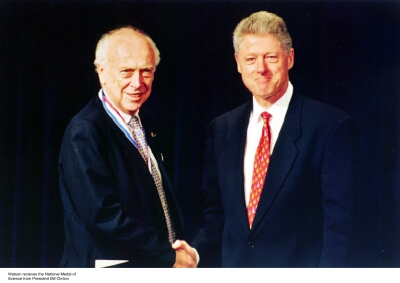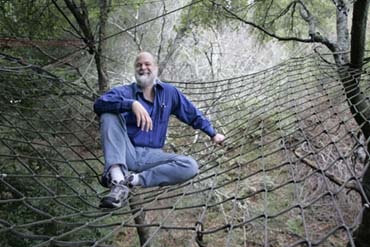James D. Watson visits Google

Nobel laureate James Watson, who discovered the structure of DNA with Francis Crick in 1953, came to Google to talk to us about his current work on the genetic basis of autism.
He talked first about the events of 50 years ago, a talk he had previously given to the Commonwealth Club.
He then talked about his work at the Cold Spring Harbor Laboratory on autism and genetics. He didn't mention the recent discovery by UCLA scientists pinpointing an autism related region on chromosome 17, but he did talk about regions on chromosome 15, and several times referred to the work of Simon Baron-Cohen on fetal testosterone.
Since males have a much higher risk of autism than females, and fetal testosterone may be involved, much of the talk and even more of the questions at the end of the talk dealt with Watson's ideas about mental differences between the sexes. He linked mathematical ability to masculinity, and said that mathematically inclined men "should marry for beauty", since there is a higher incidence of autism in children where both parents have "masculine" traits like mathematical ability. He said he thought Rosalind Franklin may have been a high intelligence autistic, and that explained why she did not deal well with potential collaborators. He said that ex-Harvard president Laurence Summers' comments about why fewer women become professional scientists or engineers was right, and that Summers' only mistake was apologizing.
This unabashed lack of political correctness got a mixed reception at Google, which has a large and growing number of respected and brilliant women scientists and engineers. While the data was not questioned, the conclusions drawn came up for discussion several times during the short question and answer period that followed the talk.
Watson also talked briefly about his involvement with the Human Genome project, and Craig Venter's shotgun approach to sequencing, which won out over the approach Watson and others originally planned for the project. He said that they had thought the shotgun approach would not be able to handle the large areas of repeats in the code, but that recent advances in computer software and hardware is making that problem less of an issue.
All in all, a surprisingly eye-opening look at a scientific icon.

0 Comments:
Post a Comment
Links to this post:
Create a Link
<< Home